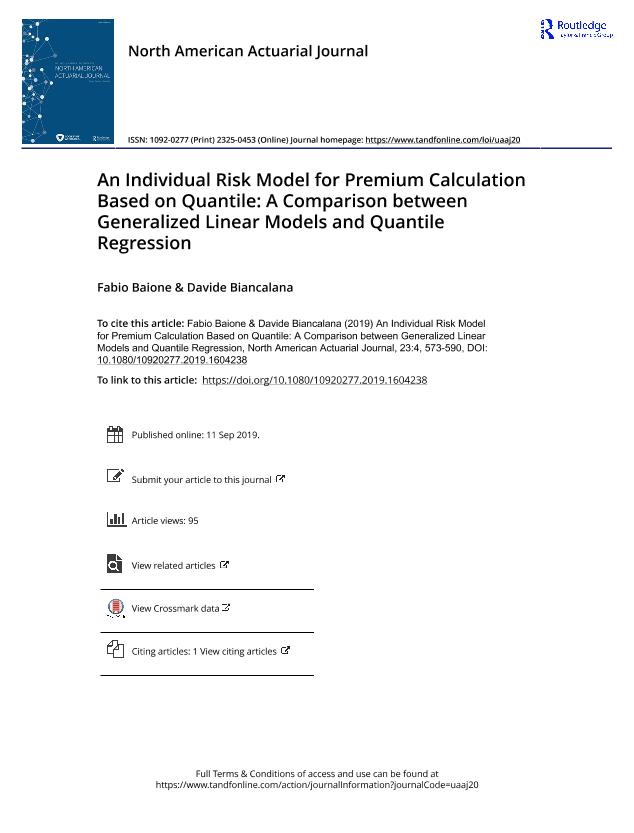An Individual risk model for premium calculation based on Quantile: a comparison between generalized linear models and quantile regression

Contenido multimedia no disponible por derechos de autor o por acceso restringido. Contacte con la institución para más información.
| Tag | 1 | 2 | Value |
|---|---|---|---|
| LDR | 00000cab a2200000 4500 | ||
| 001 | MAP20200004905 | ||
| 003 | MAP | ||
| 005 | 20200221135722.0 | ||
| 008 | 200217e20191202usa|||p |0|||b|eng d | ||
| 040 | $aMAP$beng$dMAP | ||
| 084 | $a6 | ||
| 100 | $0MAPA20180012044$aBaione, Fabio | ||
| 245 | 1 | 3 | $aAn Individual risk model for premium calculation based on Quantile: a comparison between generalized linear models and quantile regression$cFabio Baione and Davide Biancalana |
| 520 | $aThis article deals with the use of quantile regression and generalized linear models for a premium calculation based on quantiles. A premium principle is a functional that assigns a usually loaded premium to any distribution of claims. The loaded premium is generally greater than the expected value of the loss and the difference is considered to be a risk margin or a safety loading. The failure of a right charge of individual risk rate exposes the insurer to adverse selection and, consequently, to deteriorating financial results. The article aim is to define the individual pure premium rates and the corresponding risk margin in balance with some profit or solvency constraints. We develop a ratemaking process based on a two-part model using quantile regression and a gamma generalized linear model, respectively, in order to estimate the claim's severity quantiles. Generalized linear models focus on the estimation of the mean of the conditional loss distribution but have some drawbacks in assessing distribution moments other than the mean and are very sensitive to outliers. On the contrary, quantile regression exceeds these limits leading to the estimate of conditional quantiles and is more accurate for a better measurement of the variability of a risk class. The proposed methodology for premium calculation allows us to find further limits of the generalized linear model as the solution we found, under specific assumptions for a generalized linear model, is equivalent to the application of the expected value premium principle. Finally, the methodology we suggest for the two-part quantile regression allows reducing the practical issue of overmodeling and over-parameterization with respect to other proposals on the same topic. | ||
| 650 | 4 | $0MAPA20080586454$aModelos analíticos | |
| 650 | 4 | $0MAPA20080545260$aRiesgos | |
| 650 | 4 | $0MAPA20080589356$aCálculo de la prima | |
| 650 | 4 | $0MAPA20080573386$aPrima de riesgo | |
| 650 | 4 | $0MAPA20160001679$aModelos lineales generalizados | |
| 650 | 4 | $0MAPA20080602437$aMatemática del seguro | |
| 651 | 1 | $0MAPA20080638337$aEstados Unidos | |
| 700 | 1 | $0MAPA20200003441$aBiancalana, Davide | |
| 773 | 0 | $wMAP20077000239$tNorth American actuarial journal$dSchaumburg : Society of Actuaries, 1997-$x1092-0277$g02/12/2019 Tomo 23 Número 4 - 2019 , p. 573- 590 |

